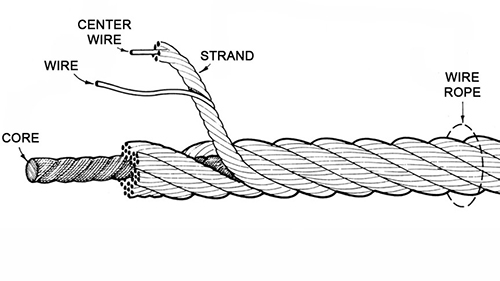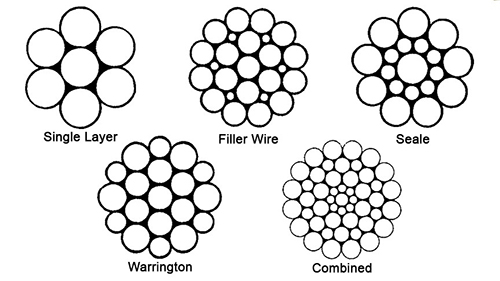Wire Rope and Steel Cable
The use of wire rope, sometimes called steel cable, steel sling rope, or steel rigging wire, is extremely popular in the material handling industry. Wire ropes come in a variety of designs and constructions, all suited for different lifting applications. Each type of wire rope has benefits and drawbacks. What all wire ropes have in common, however, is that they are made up of steel wires that form individual stands. These strands are laid in a helical pattern around a fiber or steel core to form the rope. Different wire configurations and strand structures offer specific benefits to fit virtually any rigging application. These benefits include:
- Strength
- Flexibility
- Abrasion Resistance
- Crushing Resistance
- Bending Fatigue Resistance
- Corrosion Resistance
- Rotation Resistance
Selecting the correct wire rope for your rigging application often requires the rigger to make a compromise between different steel cable properties. For example, a wire rope with a small number of large outer wires will be more resistant to crushing, but less resistant to bending fatigue. Conversely, a wire rope with a larger number of small outer wires will be more bending fatigue-resistant but less crushing-resistant. These differences not only change the way the wire rope is used but they also change the way the wire rope is to be properly cared for.
Here at Tri-State Rigging Equipment, we pride ourselves on providing our customers with only the highest quality steel wire ropes, from only the most reputable manufacturers. We can provide you with any rigging product on the market so if you cannot find what you are looking for, or if you don’t know exactly what you need, call or email our sales team to speak with a rigging product specialist.
Anatomy of a Wire Rope
Every wire rope used for rigging and lifting is comprised of three main components:
- Metal wires
- Strands formed by the individual wires
- A fiber or steel core around which the strands are laid
Variations in these three components account for nearly all the different types of wire rope cable, as well as the different benefits they offer.
The wires of a cable rope are the smallest component and are twisted together to form individual strands. Wires can be constructed in a variety of materials and grades, all affecting the properties offered by the cable rope. These materials include:
- Steel
- Iron
- Stainless Steel
- Monel
- Bronze
These different materials and grades affect the cable rope’s strength, bending fatigue resistance, corrosion resistance, wear resistance, and curve of the wire rope.
The strands of the steel cable consist of two or more wires and are laid in a helical pattern around the core. The way strands of steel cable are laid affect the properties offered by the steel cable.
The job of the core inside a steel cable rope is to support the strands and keep them in place relative to each other when bending and when under load. Wire rope cores can be made of a variety of materials including natural fiber, synthetic fiber and steel.
The lubrication of a steel cable rope is extremely important and often overlooked. Wire rope lubricant is added during the manufacturing process and penetrates the wire rope throughout, core included. The purpose of wire rope lubrication is twofold. First, it reduces friction between wires and strands. Second, it provides corrosion resistance to wires, strands and the core. A lack of proper lubrication is very serious and is cause to remove any and all affected wire rope from service.
Wire Rope Construction
When riggers talk about the construction of a wire rope they are referring to:
- Length
- Size
- Preformed or Non-Preformed
- Direction and Type of Lay
- Strand and Wire Pattern
- Grade of Rope
- Type of Core
The cable rope length and size are self-explanatory, but the rest require further explanation.
Preformed and Non-Preformed Wire Rope
In a preformed steel wire rope, the wires and strands are manufactured into the helical shape they will take when the wire rope is constructed. Preformed wire rope offers more flexibility and fatigue resistance than non-preformed wire rope. This allows the rigging wire to be uniformly spooled on a drum.
Non-preformed wire rope, on the other hand, requires less intensive manufacturing, but offers less flexibility and fatigue resistance.
Direction and Type of Wire Rope Lay
When riggers talk about the lay of a rope, they are talking about two things. One, the way the wires are laid to form a strand (right or left), and two, the way the strands are laid around the wire rope core (regular, lang, or alternate).
- Regular Lay: The wires are parallel with the core of the rope. The direction of the wires is opposite to the direction of the strands. Compared to lang laid wire rope, regular lay offers more crushing and rotation resistance, allowing it to spool better on a drum.
- Lang Lay: The wires are laid at an angle to the wire rope core. The direction of the wires is the same as the direction of the strands. Compared to other wire rope lays, lang lay offers more bending fatigue and abrasion resistance.
- Alternate Lay: Used for specialty applications, alternate lay wire rope consists of strands that alternate between regular and lang lay.
Wire Rope Strand Patterns
Wire ropes can be constructed using one of the five main strand patterns or a combination of two or more of the basic strand patterns. The wire rope strand pattern refers to the number of wires per layer, the number of layers, and the size of the wires. The strand pattern of a wire rope is a very important determining factor when it comes to choosing the correct wire rope for your specific rigging application. The five basic strand patterns are:

- Single Layer: This strand pattern is constructed by laying several wires around a center wire of the same diameter.
- Filler Wire: This strand pattern is constructed by laying two layers of same sized wires around a center. The outer layer will have 2x the amount of wires than the inner layer. In the valleys of the inner wires are small filler wires to fill in the gaps between the inner and outer layers.
- Seale: A layer of same sized wires smaller than the center wire is laid around the center. The outer layer consists of the same amount of wires as the inner layer but bigger in size. The outer wires lay in the valleys of the inner wires.
- Warrington: This strand pattern consists of two wire layers. A layer of wires is laid around a same sized center wire to form the inner layer. The outer layer is formed by laying wires of alternating sizes, big and small, around the inner layer. The larger outer wires lay in the valleys of the inner wires and the smaller outer wires lay on the crowns of the inner wires.
- Combination: A combination wire rope strand pattern is constructed by combining two or more of the strand patterns above to form a single unique strand pattern.
Grade of Wire Rope
Wire rope and steel cable can be constructed out of three types of steel, all offering different amounts of strength:
- Improved Plow Steel (IPS)
- Extra Improved Plow Steel (EIPS) – 15% stronger than IPS
- Extra Extra Improved Plow Steel (EEIPS) – 10% stronger than EIPS
Types of Wire Rope Cores
There are three main types of wire rope cores:
- Fiber Core (FC)
- Independent Wire Rope Core (IWRC)
- Wire Strand Core (WSC)
Fiber cores offer riggers more flexibility due to their natural or synthetic polypropylene fibers. This also means, however, that fiber core wire ropes are more susceptible to crushing and are not suitable for high heat environments.
In environments that exceed 180° F, a steel wire rope core should be used. Steel wire rope cores can be either an independent wire rope or an individual wire rope strand. Steel wire rope cores offer greater support for the strands and wires of the steel cable when compared to fiber cores.
Types of Wire Rope
The classification of a wire rope is based on the number of strands, as well as the number of wires in each strand. Below is a table of the most common wire rope configurations arranged in specific classifications.
| Classification |
Outer Strands |
Wires / Strands |
| 6 x 7 |
6 |
3-14 |
| 6 x 19 |
6 |
15-26 |
| 6 x 36 |
6 |
27-49 |
| 6 x 61 |
6 |
50-74 |
| 6 x 91 |
6 |
75-109 |
| 7 x 19 |
7 |
15-26 |
| 7 x 36 |
7 |
27-49 |
| 8 x 7 |
8 |
3-14 |
| 8 x 19 |
8 |
15-26 |
| 8 x 36 |
8 |
27-49 |
| 8 x 61 |
8 |
50-74 |
In addition to the general classifications of steel wire rope, here at Tri-State Rigging Equipment, we also offer a wide range of specialty wire rope constructions. These include:
- Rotation Resistant Wire Rope: This special construction of steel cable rope is designed to resist twisting and turning while under load. Rotation resistant wire rope must be specially cared for to prevent introducing twist into the rope.
- Compacted Strand Wire Rope: This special type of wire rope is constructed using compacted outer strands. The outer strands are run through rollers or a die before the rope is closed. This increases the density of the outer stands and gives the steel cable rope a smoother outer surface. Compacted strand wire ropes offer greater strength and durability than standard round wire rope.
- Swaged Wire Rope: Unlike a compacted wire rope, a swaged wire rope is compacted using a swaging machine after the wire rope had been closed. The outer wires of a swaged wire rope can be either compacted or round. Like compacted strand wire rope, swaged wire rope offers more strength and durability when compared to similar sized round wire ropes, however, it offers less bending fatigue resistance.
- Plastic Coated Wire Rope: This type of wire rope is coated in a layer of plastic to protect the rope from abrasion, wear, and environmental factors. A drawback to plastic coated wire rope is that the plastic coating covers the strands and wires making it harder to inspect the wire rope.
- Plastic Impregnated (PI) Wire Rope: A plastic impregnated wire rope is filled internally with a matrix of plastic that fills the gaps between wires and strands. This plastic filling reduces internal friction and improves bending fatigue resistance.
- Plastic Coated or Plastic Filled IWRC Wire Rope: This type of wire rope features an independent wire rope core that is either filled or coated in plastic. This reduces internal friction in the wire rope and gives the wire rope greater bending fatigue resistance.
Tri-State Rigging Equipment is a service provider and distributor for all steel wire rope and steel cable for rigging and lifting, serving clients from coast to coast, Canada, Mexico, and especially focused in the states of Missouri, Illinois, Indiana, Iowa, Kansas, Nebraska, Arkansas, Mississippi, Tennessee, Kentucky, South Carolina, Florida, and Oklahoma.